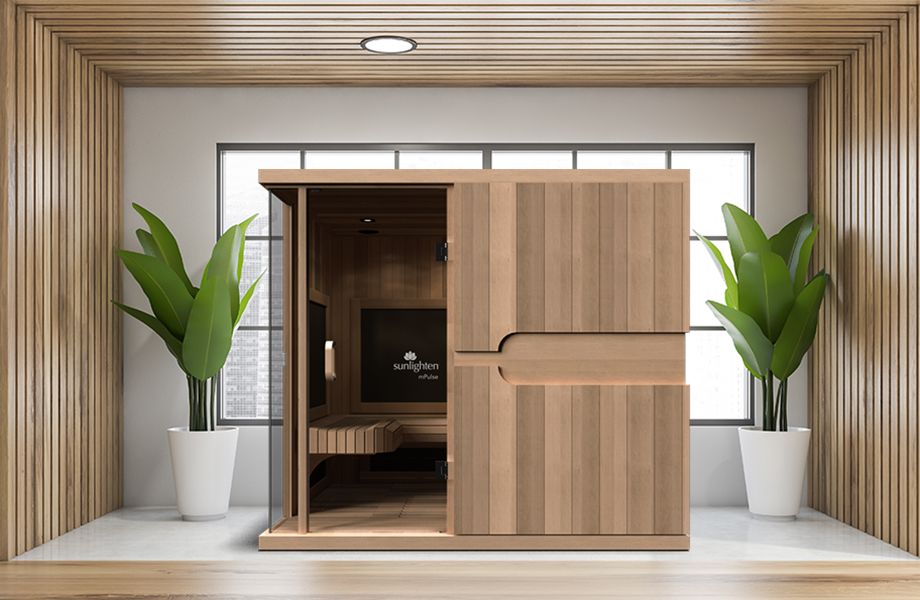Are you in search of an intimate spa experience in the comfort of your own home? You can now bring the luxury of a spa to your home with infrared saunas!
In this guide, we provide you full information about how to create a relaxing home spa experience with an infrared sauna. Enjoy detoxifying and rejuvenating your body, mind, and soul at home!
Creating a home spa with an infrared sauna is an amazing way to unwind after a stressful or tiring day. The gentle heat of an infrared sauna soothes aches and pains, inducing relaxation and aiding in deeper, more restful sleep.
An infrared sauna uses far-infrared light, which penetrates your skin rather than just heating the surrounding air like traditional steam saunas. Far-infrared light has been found to have many health benefits such as: improving flexibility and mobility; reducing inflammation; improving circulation; relieving sore muscles; removing toxins from the body; promoting skin health; enhancing the immune system; aiding in weight loss, and even promoting anti-aging effects!
The purpose of this guide is to help you create your own personal home spa with an infrared sauna. We’ll cover everything from picking out the right model for you and setting it up correctly for optimal enjoyment to creating a relaxing environment around your sauna for maximum benefit.
Brief explanation of the topic
An infrared sauna is a type of sauna that uses light to create heat. This type of sauna is often referred to as a “dry heat” sauna. Unlike traditional saunas, which rely on hot air or steam to heat up the space, infrared saunas use invisible light waves, ranging from infrared A (mid-range) to near, mid and far infrared waves which are the same rays that come from the sun. Infrared light penetrates more deeply than steam and hot air and increases body temperature more quickly than other forms of saunas.
The effects of an infrared session have several benefits such as helping with weight loss and cellulite reduction, improving circulation and healing body aches, toxins elimination from cells, relief for joint pain due to arthritis, improving skin texture by unclogging pores and increasing collagen production for glowing skin. In addition, it helps reduce stress due to its calming effect on the nervous system.
Creating a relaxing home spa with an infrared is easy – all you need is space that can fit your unit. Infrareds are usually more compact than traditional types so you can usually find one small enough for just about any size room in your home. Having this at home allows you to set aside time each day or week just for yourself – no need to book timeslots in crowded spas! Enjoy total serenity while feeling energized with the warmth of your own personal sauna.

Importance of having a relaxing home spa
Creating a relaxing home spa with an infrared sauna is the perfect way to practice self-care at any time of day. An at-home spa is a great way to relax, unwind and recharge, helping you keep your mental and physical health in top shape.
An infrared sauna can be a real game changer for stress relief and overall wellbeing. Not only does it provide general relaxation, but also has its own special benefits like increased calorie burning, improved skin elasticity, reduced muscle tension and joint pain relief. Plus it can help reduce cortisol levels which in turn can contribute to better sleep quality.
Many people find even a single session beneficial so incorporating regular sauna sessions into your home spa routine can help enhance your overall wellness and mood significantly over time.
Benefits of using an infrared sauna
An infrared sauna is a relaxing home spa device that uses infrared light to warm the body. This type of sauna is beneficial for multiple reasons, including improving overall joint health and reducing stress levels. It is also known to help with weight loss and detoxification, as well as providing sleep-promoting benefits. The following are some of the top benefits of using an infrared sauna.
Weight Loss: An infrared sauna provides a number of benefits for weight loss, including an increased metabolism and improved circulation that enables greater fat burning. Furthermore, sweating helps to reduce water retention in the body while flushing out toxins that can make losing weight difficult.
Stress Reduction: Infrared light has been known to produce feelings of relaxation due to its ability to reduce stress hormones such as cortisol and epinephrine. The feeling of comfort provided by this type of heat helps induce a deep sense of relaxation and improved mental clarity while reducing negative emotions like anxiety or depression.
Detoxification: An infrared sauna aids in cleansing the body, helping rid it of chemicals, heavy metals, toxins and other impurities through perspiration. This can leave you feeling refreshed and improve immune function as well as energy levels due to the elimination of toxins from your body’s cells.
Joint Health: Infrared light has been proven effective in relieving chronic pain conditions like rheumatoid arthritis as it increases blood flow throughout the body and promotes healing by providing direct heat to inflamed areas on a cellular level rather than just surface heat from traditional steam or hot rock saunas. This heat therapy can be incredibly beneficial for those suffering from various types of joint inflammation or stiffness resulting from sports injuries or other conditions.
Understanding Infrared Saunas
With an infrared sauna, you’ll be able to enjoy a personal home spa experience. Before investing in one for your home, it is important to understand the components of a traditional sauna and how infrared saunas differ.
Traditional Saunas: The most common type of sauna found in health clubs, gyms, and spas is the traditional steam or dry heat variety. They use traditional heated stones or electric heaters to create hot air that’s either dry or humidified with water. This type of sauna will get just as hot as an infrared one at around 175-185°F but can get even hotter and still create a scorching environment depending on the user’s preference.
Infrared Saunas: Rather than heating the air around your bodylike a traditional sauna does, an infrared one uses special “near-infrared” lights that warm your body directly (and only your body!). Typically made from wood such as cedar or light-weight materials like plastic, there are many sizes available to fit almost any budget and lifestyle. As for temperature settings, usually lower temperatures are used with most brands ranging from 120-150ºF.
What is an infrared sauna?
An infrared sauna is a type of sauna that uses light to create heat. This form of sauna is sometimes referred to as a far-infrared sauna – “far” describes where the infrared waves fall on the light spectrum. Infrared waves are invisible to the human eye – unlike traditional saunas, which use heat to warm the air, an infrared sauna heats your body directly without warming the air around you. The result is a more vigorous and deeper sweat at a lower temperature in comparison to a traditional steam or hot rock sauna.
An infrared sauna can have a number of health benefits, from detoxification and stress relief to improved circulation and overall wellness. It’s important to note that while an infrared sauna may provide some therapeutic benefits, it’s not intended as a medical device or treatment for any medical condition.
How does an infrared sauna work?
An infrared sauna uses infrared heaters to emit energy in the form of light waves which heats up the body without having to heat up the air around it. This is an efficient and effective way to use infrared heating for therapeutic effects and for providing a home spa experience.
The heat emitted by an infrared sauna penetrates deeply into the body’s tissues and organs, providing relief from pain and allowing for overall muscle relaxation.
Infrared saunas are different from regular dry or steam saunas because they use a much lower temperature than the traditional Finnish wood-burning or electric models, which can reach as high as 176°F (80°C). An infrared sauna typically operates at a temperature between 130-150°F (54-65°C). At these temperatures, users are able to relax more quickly while receiving more health benefits due to deeper penetration of heat and greater sweating.
Using an Infrared Sauna provides many benefits including detoxification through sweat, improved blood circulation, pain relief, skin cleansing, improved sleep quality, relaxation of muscles and joints, weight loss and stress reduction. These benefits are seen through exposure in a personal far Infrared Sauna more quickly due to their lower temperature when compared with traditional wet saunas.

III. Setting up Your Home Spa
Creating a spa-like atmosphere in your own home is easier than you may think. With the right elements, a few pieces of equipment and some personal touches, you can create a space that allows for relaxation, wellness and tranquility. Setting up an at-home infrared sauna is one of the best ways to transform your home into an oasis. Here are the steps you need to get started.
- Measure your room: Before you make any purchases, measure your designated area for the sauna carefully so that you can find a unit with enough room for comfortable use.
- Choose Your Material: Different saunas are made from different materials and each has various benefits and drawbacks. Look into infrared saunas with wood or metal frames—both provide insulation and aesthetically appealing options depending on your preferences!
- Compile Supplies: Make sure that you have all of the necessary supplies before installation begins—this includes plugs, outlets, switches, power strips and cables as well as safety notices that comply with local regulations if needed—these items may vary depending on what kind of infrared sauna model you choose or where it is located within your house or apartment complex.
- Ensure Safety: To ensure maximum safety while using your newly set up infrared sauna always keep an eye out for potential hazards such as water damage or leaked electricity in wet areas–your safety should be a top priority at all times! Also read through any warranties provided by the manufacturer so you can understand exactly how to care for your unit properly over time and avoid any potential issues that may arise later down the road due to improper maintenance habits (follows local code requirements).
Choosing the right location for your infrared sauna
It is important to choose the right location to place your infrared sauna. Location, when it comes to placement of a spa in the home, is key. Whether you’re looking for privacy or a more social environment, the right placement of equipment can make or break your experience. Here are some key factors to consider when deciding on where to place your infrared sauna:
-Privacy: The beauty of a home spa is that you can enjoy your leisure time privately and comfortably. Consider any area in your house that will be most conducive to relaxation, away from traffic areas and any noises from external sources such as TV’s and other distractions.
-Proximity: You want the spa area to be close enough for comfort yet far enough away for peace and quiet. If possible, try finding an area that limits access from family members (especially children).
-Safety: Because location plays such an important role in safety, make sure you take into account distance from electrical cords and outlets as well as any items of furniture or objects that could possibly be a hazard to you or others using the sauna or spending time in the room. Additionally, think about ventilation – infrared saunas don’t require much ventilation so if possible try choosing an area with a window nearby so you have access to fresh air if needed.
Preparing the space for your sauna
When setting up your infrared sauna, it’s important to consider the size of the space and the amount of heat you wish to generate. You’ll also need to consider whether your sauna will be installed in an indoor or outdoor space. Assuming that you are working with an enclosed room or isolated area indoors, you should take the following steps to ensure a safe and relaxing spa experience:
-Ventilation: Proper ventilation is key to a successful sauna session. It is best to use a pressurized system that allows air circulation while keeping airborne moisture out. This will also help reduce heating costs as well as prolong your equipment’s lifespan.
-Lighting: Infrared saunas do benefit from an ample source of light, but ensure that it doesn’t affect the temperature of your space too much by using low energy bulbs or task specific lighting rather than overhead lighting whenever possible.
-Sound: The ambiance created by sound can be just as effective in reducing stress as any visuals can be – but keep it gentle and non confrontational for optimal relaxation! Use sound machines or play calming music instead of anything upbeat or harsh.
-Temperature: The ideal temperature for a infrared sauna should ideally range between 25-50°Celsius (77-122°F). Adjust accordingly if you feel too hot or cold during your session for optimal comfort levels.
-Privacy: Setting up draperies, blinds, curtains or other visual barriers around your sauna will help create an even more serene environment perfect for unwinding after a stressful day.
Installing your infrared sauna
Installing an infrared sauna in your home provides a easy way to relax and unwind after a long day. With the right planning and equipment, creating a spa-like atmosphere in your own home is a possibility. Before you purchase an infrared sauna, it is important to have an understanding of the installation process and any special requirements for mounting the unit.
When installing an infrared sauna, there are several elements to consider:
- Space – Determine where there is adequate space for both the installation of the unit and comfortable seating for your spa experience.
- Heating elements – Consider proper ventilation that meets manufacturer specifications as well as potential electrical code requirements if installing near any outlets or electrical components.
- Seating options – Evaluate what type of seating you would like inside your infrared sauna including benches or chairs, head rests or even audio systems such as bluetooth speakers to further enhance relaxation vibes while sitting in your infrared sauna.
- Accessories- Consider additional items such as aromatherapy diffusers or headrests designed specifically for infrared saunas to complete the look of your at-home spa oasis!
It is important to consult with a licensed contractor prior to installation who will be able to provide guidance on safe installation practices and ensure compliance with local building codes that may apply in areas where the device is being installed. Following manufacturer’s instructions for assembly should also help ensure that all safety precautions are met before experiencing your relaxing home spa with an infrared sauna!

Conclusion
Creating your own home spa by adding an infrared sauna can be an exciting and rewarding experience. You will be able to enjoy the many benefits of a sauna without leaving the comfort of your home. In addition to a delicious relaxation session, an infrared sauna can improve cardiovascular health and increase circulation, helping you to feel healthier overall.
Whether you choose portable or full-sized models, there are a variety of infrared saunas that are easily installed in any home setting. Keeping in mind factors such as size, cost, and type of wood used for construction, you’ll be able to find one that best suits your needs for a soothing spa retreat. With regular use, your home sauna can offer years of relaxation and invigoration!
FAQ’s
Can I put an infrared sauna in my house?
Yes, you can put an infrared sauna in your house.
How can I make my infrared sauna more comfortable?
You can make your infrared sauna more comfortable by adjusting the temperature, using a towel to sit on, and bringing in music or a book.
How do you set up an infrared sauna at-home?
You can set up an infrared sauna at-home by choosing a suitable location, assembling the sauna, and connecting it to a power source.
Where should an infrared sauna be placed in a house?
An infrared sauna should be placed in a well-ventilated area, away from flammable materials, and on a flat surface.
Is it OK to sit in an infrared sauna every day?
It is generally safe to sit in an infrared sauna every day, but it’s recommended to start with shorter sessions and gradually increase the duration.
Do infrared saunas use a lot of electricity?
Infrared saunas are generally more energy-efficient than traditional saunas, but their power consumption can vary depending on the model and usage.
Are there any negatives to infrared sauna?
Some potential negatives to infrared sauna include dehydration, overheating, and potential skin irritation.
Who Cannot use infrared sauna?
People with certain medical conditions such as heart disease, high blood pressure, and pregnancy should consult with a doctor before using an infrared sauna.
Why is my skin so soft after infrared sauna?
Infrared sauna can promote increased blood flow, which can help improve skin texture and hydration.
Why don’t I sweat in infrared sauna?
Sweating can vary based on individual factors such as hydration levels and body composition, but it’s also possible that the temperature of the infrared sauna may not be high enough to induce sweating.
See Also :
- Best sauna suits 2023
- Best sauna suits for weight loss 2023
- Best sauna suit for men 2023
- Best sauna heaters 2023
- Best sauna for home 2023


